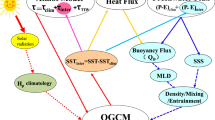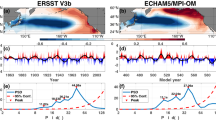Abstract
This study investigates the roles of multiple ocean-atmospheric feedbacks in the oceanic response to increased carbon dioxide by applying an overriding technique to a coupled climate model. The annual-mean sea surface temperature (SST) response in the Indian Ocean exhibits a zonal-dipolar warming pattern, with a reduced warming in the eastern and enhanced warming in the western tropical Indian Ocean (TIO), reminiscent of the Indian Ocean Dipole (IOD) pattern. The development of the dipole pattern exhibits a pronounced seasonal evolution. The overriding experiments show that the wind–evaporation–sea surface temperature (WES) feedback accounts for most of the enhanced warming in the western and central TIO during May–July with reduced southerly monsoonal wind and contributes partially to the reduced warming in the eastern TIO during June–September. The Bjerknes feedback explains most of the reduced warming in the eastern TIO during August-October, accompanied by a reduction of precipitation, easterly wind anomalies, and a thermocline shoaling along the equator. Both feedbacks facilitate the formation of the dipolar warming pattern in the TIO. The residual from the Bjerknes and WES feedbacks is attributable to the “static” response to increasing CO2. While the static SST response also contributes to the seasonal SST variations, the static precipitation response is relatively uniform in the TIO, appearing as a general increase of precipitation along the equatorial Indian Ocean during June–September.







Similar content being viewed by others
References
Biasutti M, Sobel AH (2009) Delayed Sahel rainfall and global seasonal cycle in a warmer climate. Geophys Res Lett 36, L23707. doi:10.1029/2009GL041303
Bjerknes J (1969) Atmospheric teleconnections from the equatorial Pacific. Mon Weather Rev 97:163–172
Cai W, Cowan T (2013) Why is the amplitude of the Indian Ocean Dipole overly large in CMIP3 and CMIP5 climate models? Geophys Res Lett 40:1200–1205. doi:10.1002/grl.50208
Chadwick R, Boutle I, Martin G (2013) Spatial patterns of precipitation change in CMIP5: why the rich do not get richer in the tropics. J Clim 26:3803–3822
Clement AC, Seager R, Cane MA, Zebiak SE (1996) An ocean dynamical thermostat. J Clim 9:2190–2196
Collins WD et al (2006) The Community Climate System Model version 3 (CCSM3). J Clim 19:2122–2143
DiNezio PN, Clement AC, Vecchi GA, Soden BJ, Kirtman BP, Lee S-K (2009) Climate response of the equatorial Pacific to global warming. J Clim 22:4873–4892
Du Y, Xie S-P (2008) Role of atmospheric adjustments in the tropical Indian Ocean warming during the 20th century in climate models. Geophys Res Lett 35, L08712. doi:10.1029/2008GL033631
Dwyer JG, Biasutti M, Sobel AH (2014) The effect of greenhouse gas-induced changes in SST on the annual cycle of zonal mean tropical precipitation. J Clim 27:4544–4565
Held IM, Soden BJ (2006) Robust response of the hydrological cycle to global warming. J Clim 19:5686–5699
Huang P, Xie S-P, Hu K, Huang G, Huang R (2013) Patterns of the seasonal response of tropical rainfall to global warming. Nat Geosci 6:357–361
Ihara C, Kushnir Y, Cane MA, de la Peña VH (2009) Climate change over the equatorial Indo-Pacific in global warming*. J Clim 22:2678–2693
Johnson NC, Xie S-P (2010) Changes in the sea surface temperature threshold for tropical convection. Nat Geosci 3:842–845
Knutson TR, Manabe S (1995) Time-mean response over the tropical Pacific to increased CO2 in a coupled ocean–atmosphere model. J Clim 8:2181–2199
Li G, Xie S-P, Du Y (2015) Monsoon-induced biases of climate models over the tropical Indian Ocean with implications for regional climate projection. J Clim 28:3058–3072
Liu Z, Varvus S, He F, Wen N, Zhong Y (2005) Rethinking tropical oceanic response to global warming: The enhanced equatorial warming. J Clim 18:4684–4700
Lu J, Zhao B (2012) The role of oceanic feedback in the climate response to doubling CO2. J Clim 25:7544–7563. doi:10.1175/JCLI-D-11-00712.1
Lu J, Vecchi G, Reichler T (2007) Expansion of the Hadley cell under global warming. Geophys Res Lett 34, L06805. doi:10.1029/2006GL028443
Lu J, Chen G, Frierson D (2008) Response of the zonal mean atmospheric circulation to El Niño versus global warming. J Clim 21:5835–5851
Luo Y, Lu J, Liu F, Liu W (2014) Understanding the El Niño-like oceanic response in the tropical Pacific to global warming. Clim Dyn. doi:10.1007/s00382-014-2448-2
Meyers G, McIntosh P, Pigot L, Pook M (2007) The years of El Niño, La Niña, and interactions with the tropical Indian Ocean. J Clim 20:2872–2880
Saji NH, Goswami BN, Vinayachandran PN, Yamagata T (1999) A dipole mode in the tropical Indian Ocean. Nature 401:360–363
Seth A, Rauscher SA, Biasutti M, Giannini A, Camargo S (2013) CMIP5 projected changes in the annual cycle of precipitation in monsoon regions. J Clim 26:7328–7351
Tokinaga H, Xie S-P, Deser C, Kosaka Y, Okumura YM (2012) Slowdown of the Walker circulation driven by tropical Indo-Pacific warming. Nature 491:439–443
Vecchi GA, Soden BJ (2007) Increased tropical Atlantic wind shear in model projections of global warming. Geophys Res Lett 34, L08702. doi:10.1029/2006GL028905
Vecchi GA, Soden BJ, Wittenberg AT, Held IM, Leetmaa A, Harrison MJ (2006) Weakening of tropical Pacific atmospheric circulation due to anthropogenic forcing. Nature 441:73–76
Webster PJ, Moore AM, Loschnigg JP, Leben RR (1999) Coupled ocean–atmosphere dynamics in the Indian Ocean during 1997–98. Nature 401:356–360
Xie S-P, Philander G (1994) A coupled ocean–atmosphere model of relevance to the ITCZ in the eastern Pacific. Tellus 46A:340–350
Xie S-P, Deser C, Vecchi GA, Ma J, Teng H, Wittenberg AT (2010) Global warming pattern formation: sea surface temperature and rainfall. J Clim 23:966–986
Yamagata T, Behera SK, Luo JJ, Masson S, Jury MR, and Rao SA (2004) Coupled ocean–atmosphere variability in the tropical Indian Ocean. Earth’s Climate: The Ocean–atmosphere Interaction, Geophys. Monogr., Vol. 147, Amer. Geophys. Union, 189–211
Yeager SG, Shields CA, Large WG, Hack JJ (2006) The low-resolution CCSM3. J Clim 19:2545–2566
Zheng X-T, Xie S-P, Vecchi GA, Liu Q, Hafner J (2010) Indian Ocean dipole response to global warming: analysis of ocean-atmospheric feedbacks in a coupled model. J Clim 23:1240–1253
Zheng X-T, Xie S-P, Du Y, Liu L, Huang G, Liu Q (2013) Indian Ocean dipole response to global warming in the CMIP5 multimodel ensemble*. J Clim 26:6067–6080
Acknowledgments
The authors would like to acknowledge helpful suggestions from Dr. Xiaotong Zheng. WL is supported by NSF AGS-1249145. JL was supported by the Office of Science of the US Department of Energy as part of the Regional and Global Climate Modeling program.
Author information
Authors and Affiliations
Corresponding author
Additional information
Responsible Editor: Xiaoming Zhai
This article is part of the Topical Collection on Atmosphere and Ocean Dynamics: A Scientific Workshop to Celebrate Professor Dr. Richard Greatbatch's 60th Birthday, Liverpool, UK, 10-11 April 2014
Rights and permissions
About this article
Cite this article
Liu, W., Lu, J. & Xie, SP. Understanding the Indian Ocean response to double CO2 forcing in a coupled model. Ocean Dynamics 65, 1037–1046 (2015). https://doi.org/10.1007/s10236-015-0854-6
Received:
Accepted:
Published:
Issue Date:
DOI: https://doi.org/10.1007/s10236-015-0854-6




